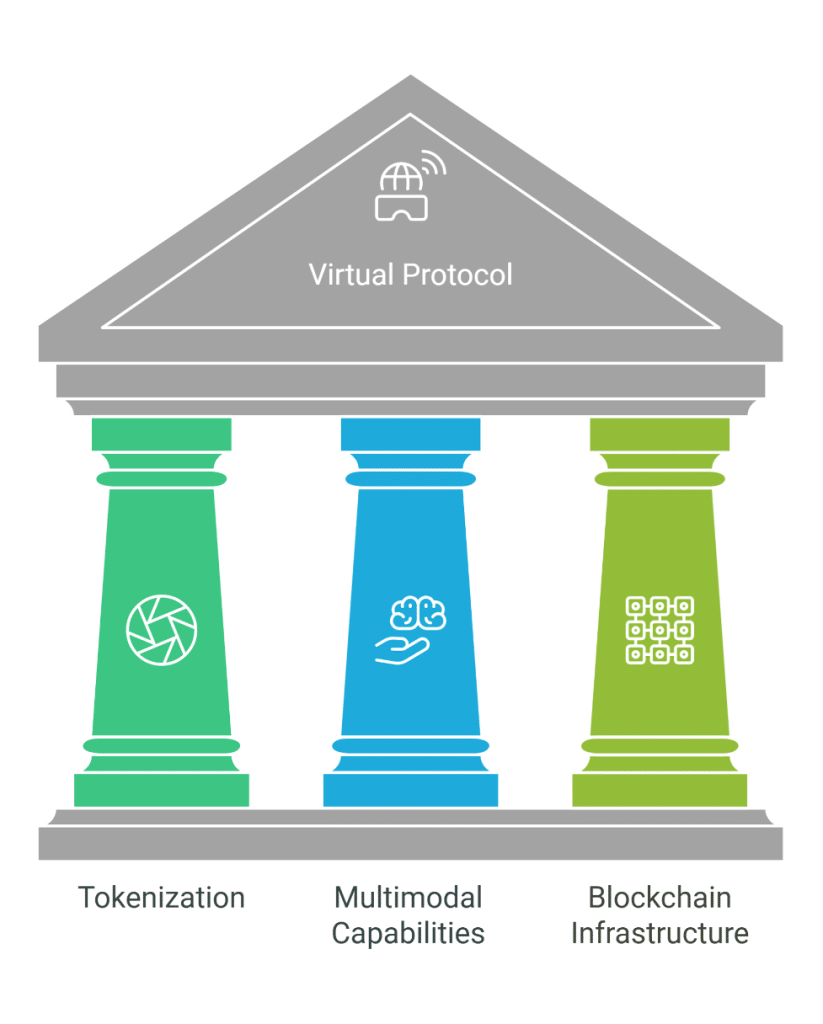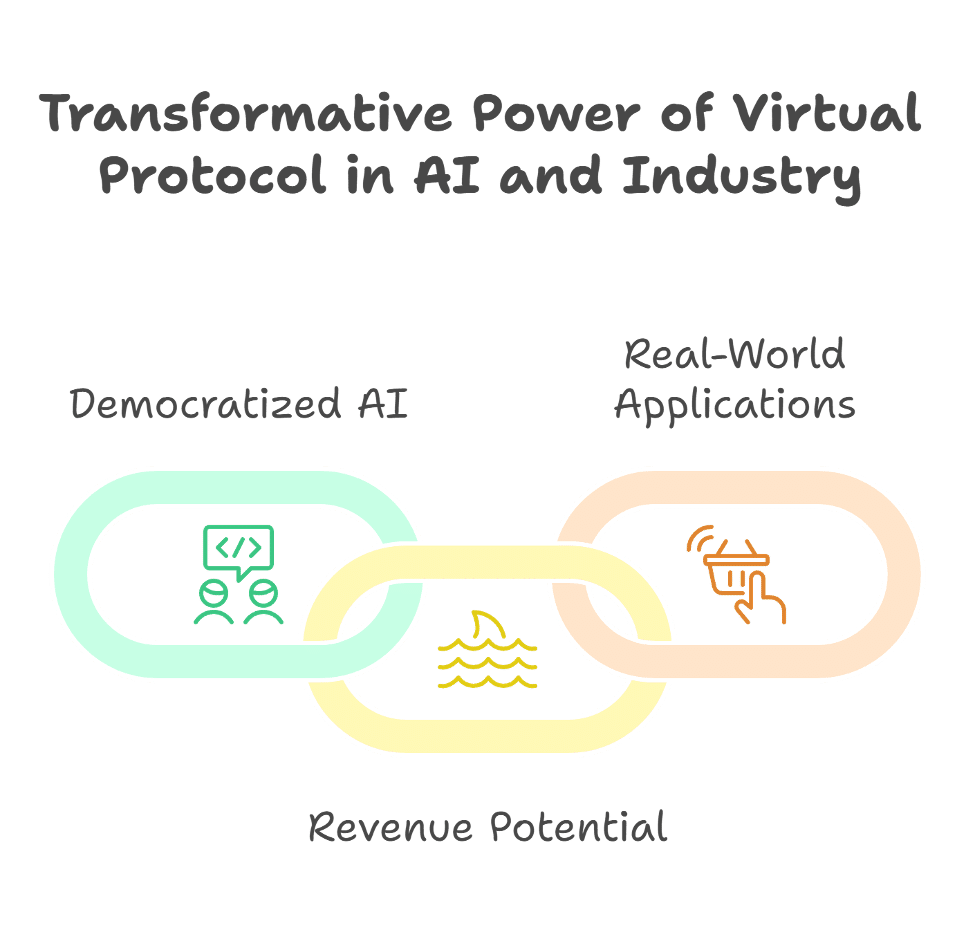Technology today is pushing boundaries like never before, and Virtual Protocol is a shining example of how innovation can transform the way we interact with artificial intelligence (AI) and blockchain. This platform doesn’t just combine these two fields—it builds something entirely new: a system where AI agents are tokenized, managed, and monetized seamlessly. Let’s dive into what makes Virtual Protocol so groundbreaking.
Breaking Down Virtual Protocol
Virtual Protocol is a blockchain-powered platform that allows users to create and manage AI agents as digital assets. These agents operate autonomously, performing tasks ranging from customer support to generating content, all while being governed and monetized through blockchain mechanisms. Built on Ethereum’s Layer 2, it ensures both scalability and cost-efficiency without compromising security.
How Virtual Protocol Works
At the heart of the Virtual Protocol crypto project lies a fascinating blend of blockchain technology and AI functionality. Here are the main components that drive this platform:

1. Tokenizing AI Agents
Every AI agent on the platform is tokenized as an ERC-20 asset, which means:
- Ownership is Shared: Token holders collectively own the agent, making AI development accessible and collaborative.
- Value is Tangible: These tokens can be traded, giving the agents a financial value based on demand and utility.
2. Multimodal Capabilities
Virtual Protocol equips AI agents with the ability to:
- Generate natural language responses.
- Synthesize human-like speech.
- Interact directly with blockchain applications, managing on-chain wallets and transactions.
This versatility means the agents can handle complex tasks autonomously, from providing customer support to executing financial operations.
3. Blockchain Infrastructure
Using Ethereum’s Layer 2, Virtual Protocol offers:
- High Speed: Transactions are processed quickly to accommodate high volumes.
- Low Costs: Reduced fees make it affordable for users to deploy and interact with agents.
- Transparency: Every transaction and operation is recorded immutably, ensuring trust.
What Makes Virtual Protocol Stand Out?

Virtual Protocol isn’t just a tech tool; it’s a platform reshaping industries. Here’s why:
- Democratized AI Development Anyone can define an AI agent’s personality and functionality using intuitive text-based inputs. This simplicity means even non-experts can participate in building and benefiting from AI technology.
- Revenue Potential AI agents generate revenue through activities like selling virtual goods or performing automated services. These earnings are then shared among token holders, creating an incentive-driven ecosystem.
- Real-World Applications Virtual Protocol’s agents aren’t just theoretical. They’re already making waves in industries like:
- Entertainment: Virtual performers and influencers engage audiences, generating both revenue and fan interaction.
- Customer Service: AI agents handle queries with human-like empathy and efficiency.
- Finance: Autonomous agents manage wallets, execute transactions, and even offer analytical insights.
Examples of Virtual Protocol in Action
One standout example is Luna, a virtual K-pop star created using the platform. Luna interacts with fans on social media and messaging apps, showcasing the power of AI-driven engagement. This kind of innovation opens doors for artists, brands, and creators to explore new ways of connecting with audiences.

The Mechanics of AI and Blockchain Integration
To truly appreciate Virtual Protocol, you need to understand how it brings AI and blockchain together:
- Decentralized Governance Token holders vote on decisions affecting the AI agent’s functionality and updates. This ensures the agent evolves based on collective input rather than centralized control.
- Smart Contracts These automated agreements handle revenue distribution, governance, and even the day-to-day operations of the agents. By eliminating intermediaries, they streamline operations while maintaining accountability.
- Autonomy in Action AI agents are designed to operate independently, whether it’s interacting with users or managing financial assets. This independence reduces the need for constant human oversight.
A Look at the Challenges
No groundbreaking innovation comes without hurdles. Virtual Protocol faces challenges like:
- Scalability Demands: As adoption increases, the platform needs to maintain low fees and high speeds.
- Regulatory Risks: Blockchain projects must navigate an ever-changing regulatory landscape, which could impact operations.
However, these challenges are manageable with ongoing development and adaptation.

How Virtual Protocol Redefines Monetization
Monetization on this platform is straightforward yet powerful. AI agents generate revenue through their activities, and earnings are distributed among token holders. This shared model ensures that every stakeholder benefits from the agent’s success.
What’s Next for Virtual Protocol?
As industries continue to explore AI and blockchain, Virtual Protocol is positioned to lead the charge. Potential developments include:
- Expanding the scope of agent capabilities.
- Enhancing scalability through advanced Layer 2 solutions.
- Building partnerships with businesses to unlock new applications.
Final Thoughts
Virtual Protocol isn’t just a glimpse into the future; it’s happening now. By blending the autonomy of AI with the security and transparency of blockchain, this platform offers a dynamic solution for industries looking to innovate. Whether it’s redefining entertainment, enhancing customer service, or automating business processes, Virtual Protocol proves that the possibilities of combining AI and blockchain are endless.
